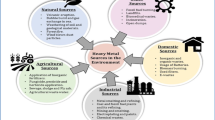Abstract
Effect of addition of municipal solid waste compost (MSWC) on two metals viz. copper (Cu) and zinc (Zn) contents of submerged rice paddies were studied. Experiments were conducted during the three consecutive wet seasons from 1997 to 1999 on rice grown under submergence, at the Experimental Farm of Calcutta University, India. A sequential extraction method was used to determine the metal (Cu and Zn) fractions in MSWC and cow dung manure (CDM). Both metals were significantly bound to the organic matter and Fe and Mn oxides in MSWC and CDM. Metal content in rice straw was higher than in rice grain. Metal bound with Fe and Mn oxides in MSWC and CDM best correlated with straw and grain metal followed by exchangeable and water soluble fractions. Carbonate, organic matter bound and residual fractions in MSWC and CDM did not significantly correlate with rice straw and grain metal. The MSWC would be a valuable resource for agriculture if it can be used safely, but long-term field experiments with MSWC are needed to assess by regular monitoring of the metal loads and accumulation in soil and plants.


Similar content being viewed by others
References
Adriano DC (1986) Trace elements in the terrestrial environment. Springer-Verlag, NY
Adriano DC (1992) Biogeochemistry of trace metals. Lewis Publishers, CRC Press, Boca Raton, FL
Alloway BJ (1990) Heavy metals in soils. Blackie, Glasgow, UK
Alva AK, Huang B, Paramasivam S (2000) Soil pH affects copper fractionation and phytotoxicity. Soil Sci Soc Am J 64:955–962
Beckett PHT (1989) The use of extractants in studies on trace metals in soils, sewage sludges, and sludge treated soils. Adv Soil Sci 9:143–176
Bell P, James BR, Chaney RL (1991) Heavy metal extractability in long-term sewage sludge and metal salt amended soils. J Environ Qual 20:481–486
Bhattacharyya P, Pal R, Chakraborty A, Chakrabarti K (2001) Microbial biomass and its activities of a laterite soil amended with municipal solid waste compost. J Agron Crop Sci 187:207–211
Bhattacharyya P, Pal R, Chakrabarti K, Chakraborty A (2004) Effect of composting on extractability and relative availability of heavy metals present in Calcutta municipal solid waste. Arch Agron Soil Sci 50:181–187
Brun LA, Maillet J, Hinsinger P, Pepin M (2001) Evaluation of copper availability to plants in copper-contaminated vineyard soils. Environ Pollut 111:293–302
Cao ZH, Hu ZY (2000) Copper contamination in paddy soils irrigated with wastewater. Chemosphere 41:3–6
Carbonell-Barrachina AA, Jugsujinda A, DeLaune RD, Patrick WH Jr (1999) The influence of redox chemistry and pH on chemically active forms of arsenic in sewage sludge-amended soil. Environ Int 25:613–618
Chen B, Shan XQ, Qian J (1996) Bioavailability index for quantitative evaluation of plant availability of extractable soil trace elements. Plant Soil 86:275–283
Chirenje T, Rivero C, Ma LQ (2002) Leachability of Cu and Ni in wood ash-amended soil as impacted by humic and fulvic acid. Geoderma 108:31–47
Dolui AK (1977) Characteristics and genesis of different alluvial soils of West Bengal. Ph.D. Thesis, University of Calcutta, India
Epstein E (1997) The science of composting. Technomic Publishing Co. Inc., Lancaster, Pennsylvania 17604, USA
Ghosh AK, Bhattacharyya P (2004) Arsenate sorption by reduced and reoxidised rice soils under the influence of organic matter amendments. Environ Geol 45:1010–1016
Harada Y, Inoko A (1980) The measurement of the cation exchange capacity of composts for the estimation of the degree of maturity. Soil Sci Plant Nutr 26:127–134
He Xin-Tao, Traina SJ, Logan TJ (1992) Chemical properties of municipal solid waste composts. J Environ Qual 21:318–329
Indian Department of Agriculture (1995) Soil test-based fertilizer recommendations for principal crops and cropping sequences in West Bengal, Govt. of West Bengal, Calcutta, India
Kabata-Pendias A, Pendias H (1992) Trace elements in soils and plants. CRC Press, Boca Raton, FL
Kitagishi K, Yamane I (1981) Heavy metals pollution in soils of Japan. Japan Science Society Press, Tokyo, pp 66–80
Kononova M (1966) Soil organic matter. 2nd English edn. Pergamon Press, Oxford, London
Lindsay WL, Norvell WA (1978) Development of a DTPA soil test for zinc, iron, manganese and copper. Soil Sci Soc Am J 42:421–428
McLaughlin MJ, Hamon RE, McLaren RG, Speir TW, Rogers SL (2000) Review: a bioavailability-based rationale for controlling metal and metalloid contamination of agricultural land in Australia and New Zealand. Aust J Soil Res 38:1037–1086
Nelson DW, Sommers LF (1975) A rapid and accurate method for estimating organic carbon in soil. Proc Indiana Acad Sci 84:456–462
Page AL, Miller RH, Keeney DR (1982) Methods of soil analysis, Part 2, 2nd Edn, Soil Science Society of America, Madison, USA
Pietrzak U, McPhail DC (2004) Copper accumulation, distribution and fractionation in vineyard soils of Victoria, Australia. Geoderma 122:151–166
Ponnamperuma FN (1972) The chemistry of submerged soils. Adv Agron 24:26–92
Sankaram A (1966) A laboratory manual for agricultural chemistry. Asia Publishing House, Calcutta, India
Shiralipur A, McConnel DM, Smith DH (1992) Uses and benefits of MSW compost : A review and assessment. Biomass Bioenergy 3:267–279
Stratton ML, Barker AV, Rechcigl JE (1995) Compost. In: Rechcigl JE (eds) Soil amendments and environmental quality. Lewis Publishers, NY
Wang Xiao-ping, Shan Xiao-Quan, Zhang Shu-zhen, Wen Bei (2004) A model for evaluation of the phytoavailability of trace elements to vegetables under the field conditions. Chemosphere 55:811–822
Zheljazkov DV, Warman PW (2004) Phytoavailability and fractionation of copper, manganese and zinc in soil following application of two composts to four crops. Environ Pollut 131:187–195
Author information
Authors and Affiliations
Corresponding author
Rights and permissions
About this article
Cite this article
Bhattacharyya, P., Chakraborty, A., Chakrabarti, K. et al. Copper and zinc uptake by rice and accumulation in soil amended with municipal solid waste compost. Environ Geol 49, 1064–1070 (2006). https://doi.org/10.1007/s00254-005-0150-8
Received:
Accepted:
Published:
Issue Date:
DOI: https://doi.org/10.1007/s00254-005-0150-8




